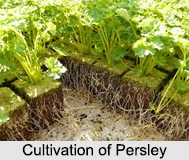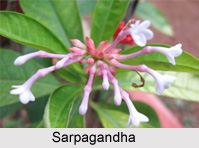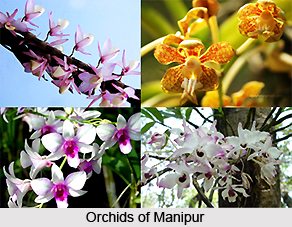 Parsley, also known as Petroselinum Hortense, is a species of Petroselinum that belongs to the Apiaceae family. The garden variety of the Indian herb Parsley Leave is usually bright green and hairless biennial plant. The ideal temperature to cultivate Parsley is 22-30 degree Celsius and it usually grows from seed. Parsley is called in various other names in India. It is called Achu Mooda in Kannada, Ajmood in Hindi language and Kothambeluri in Malayalam language. Parsley is mainly an herb, which is traditionally not much accepted in India, but it has acquired popularity only recently in urban areas due to global influence. It grows well in the higher altitudes in India and locally it is called Seema Malli and Ajmood. The word parsley is a combination of the Old English petersilie and the Old French peresil, both of which have been derived from Medieval Latin petrosilium.
Parsley, also known as Petroselinum Hortense, is a species of Petroselinum that belongs to the Apiaceae family. The garden variety of the Indian herb Parsley Leave is usually bright green and hairless biennial plant. The ideal temperature to cultivate Parsley is 22-30 degree Celsius and it usually grows from seed. Parsley is called in various other names in India. It is called Achu Mooda in Kannada, Ajmood in Hindi language and Kothambeluri in Malayalam language. Parsley is mainly an herb, which is traditionally not much accepted in India, but it has acquired popularity only recently in urban areas due to global influence. It grows well in the higher altitudes in India and locally it is called Seema Malli and Ajmood. The word parsley is a combination of the Old English petersilie and the Old French peresil, both of which have been derived from Medieval Latin petrosilium.
Features of Parsley
Parsley is an aromatic biennial umbelliferous herb, which can often last up to 4 years, producing a rosette of finely divided radical leaves in the first year and a flowering stalk, up to 100 cm high in the second year. It has rich green compound leaves; two or three pinnate. Flowers of Parsley are yellowish green in compound umbels; fruits are (commonly known as seeds) 2 to 3 mm long, crescent shaped, conspicuously ridged, consisting of two mericarps. Seeds and leaves of the plant are used as spice. The colour of the dried herb is green and its aroma is pleasant. Dried herb is available as rubbed, whole or ground form.
Types of Parsley
There are two prominent varieties of horticultural Parsleys; the two types are cultivated for the leaves and grown for their turnip-like roots. The former type of parsley is cultivated only in India. In case of the latter, roots are cut after the fruits are harvested. The roots of Parsley are sliced longitudinally to facilitate drying. The seeds are used for the extraction of Parsley oil for the commercial purpose. However, the aroma of the seeds is less than that of leaves. Two to five cuttings of leaves are possible for each planting before flowering. Within the leafy varieties, Parsley has been developed into 3 types of foliage, namely plain foliage, the double curled leaf, and the moss curled or triple curled leaf. The fleshy-rooted Parsley has plain celery like leaves.
 Sowing of Parsley
Sowing of Parsley
Parsley is a cool weather crop, which grows best in a rich moist soil, amenable to deep cultivation. In India, the herb grows better at higher altitude. It is grown occasionally in gardens. Sowing is done between the months of March and May on the hills and from August to November in the plains.
Chemical Elements in Parsley
Analysis of the green leaves of parsley suggests that it contains 68.4 percent moisture, 5.9 percent protein, 1.0 percent fat, 19.7 percent carbohydrates, 1.8 percent fiber, 3.2 percent total ash, 390 mg/100 gram calcium, 200 mg/100 gram phosphorus, 17.9 mg/100 gram iron, 3200 I.U/100 gram Vitamin A (carotene), 0.04 mg/100 gram Thiamine, 0.5 mg/100 gram Nicotinic acid, 281 mg/100 gram Vitamin C (ascorbic acid). There is also the presence of biotin and Riboflavin. The stems, leaves and fruits contain a glucoside apiin, which on hydrolysis yields apigenin, glucose and a sugar; apiose: a second glucoside, consisting of lute Olin, glucose and apiose have also been reported.
Essential Oil of Parsley
The plant of Parsley contains an essential oil which is responsible for the characteristic aroma and flavour. The oil is recovered by steam distillation and is used primarily for flavouring food products. Commercial Parsley oil is distilled either from the aerial parts of the herb bearing immature fruits (herb oil, yield about 0.25 percent) or from the mature fruits (fruit oil, yield up to 7 percent). The herb oil possesses a superior aroma and is more esteemed than the fruit oil. There is considerable difference in the physico-chemical characteristics of the herb and the seed oil.
Uses of Parsley
The fruit oil of Parsley contains apiol (parsley camphor) and alpha-pinene, with small amounts of aldehydes, myristin, ketones and phenols. The fruit yields about 20 percent of greenish fatty oil with a peculiar odour and disagreeable sharp flavour. The oil has a high content of Petroselinic acid (up to 76 percent). It can be tried for a number of industrial purposes, such as making of synthetic rubber, plastics, protective coatings and lubricating oil additives. Besides, leaves of this herb are also useful for medicinal benefits.
Parsley has several culinary uses as well. Curly parsley is usually utilised as a garnish. Green parsley is generally used as a garnish on rice dishes, potato dishes, on fried chicken, fish, lamb, goose, meat, steaks or vegetable stews. However, parsley should not be consumed in large amounts, because it may have uterotonic effects on the consumer.











